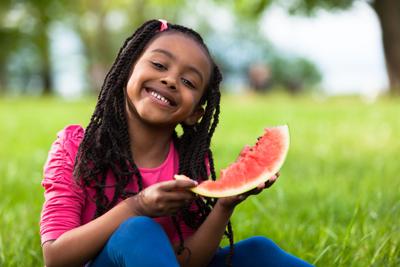You see, I will never be too Black or too proud to enjoy a slice or two of cold sweet watermelon, the way many of us enjoyed watermelon, back in the day.
Maybe you are old enough to remember the postcards, greeting cards, games and advertising materials depicting a grinning Black person biting on a slice of watermelon.
Perhaps you have experienced shopping in a supermarket, only to have a white person ask you for assistance in picking a good watermelon. You understand the thought process on their part; Black folk and watermelon go hand in hand and thus all Black folk know how to pick a good watermelon.
It is alleged that during slavery, white people allowed Blacks to raise chickens because it was an inexpensive enterprise and chickens were plentiful. Watermelons were also inexpensive and yielded abundantly. Just one of these sweet and succulent melons could feed an entire family. So you developed a taste for watermelon. While this may not apply to you, it certainly applies to me.
Regardless of the stereotypes and the attempts at ridicule, beyond my bow ties, wire rim glasses, three piece suits and ultra-conservative presentation, I am not ashamed to admit that I love watermelon. Unlike some of you, who hide to eat your watermelon, I am not ashamed to eat it out in public. If anyone hears about a watermelon eating contest, enter my name as my love for watermelon will enable me to “out eat” any contestant. I love watermelon today just as much as many of our ancestors did, back in the day.
As a lover of watermelon, there are things obvious to me today. Perhaps you have noticed that watermelons today do not look the same as they did back in the day. Have you tried to find a large, dark green, round watermelon in a supermarket today? When did you last see the large, oblong zebra stripped watermelon? Whenever I think of these watermelons, I think about the days when you would have them plugged. The store or proprietor would cut a small triangle shape into the watermelon and give it to you to taste before it was purchased. I often wondered what was done with the rejected watermelons. But then again, back then, watermelons were so good that you seldom encountered a bad one. But today, what you find are small, light green watermelons.
When I purchased my last watermelon, I focused on the sign that read “seedless watermelons.” Obviously, it was not the first time that I purchased a seedless one but, I suspect like many of you, I had not given thought to how seedless watermelons are produced. An article, “Seedless Watermelon Production,” by Jerry Parsons and others and published by the Texas Agricultural Extension Service, provides a detailed description of how seedless watermelons are produced. In summary, they are genetically produced.
Seedless watermelons can be sweet, but, if you grew up during my era, you know that the best watermelons contained seeds and were sold by the hucksters from their wagons in the streets. Very seldom were watermelons purchased from supermarkets and stores. You might recall horse drawn wagons going through neighborhoods loaded with watermelons. I can still see my father flagging down the huckster to purchase one. Those working on the wagons seemed to have their own system for selecting a watermelon. It was either the sound when plucking it or the length of the stem from the vine. The yellow color on the bottom of the watermelon was another important factor according to the huckster as this denoted how long the watermelon had been on the ground and this determined if was ripe. Back in the day there was a fool proof, guaranteed method that allowed you to purchase a sweet watermelon, referring to the plugging referenced earlier.
While buying a watermelon can be a real challenge, eating a watermelon today is much different than it was, back in the day. I will tell you that there is nothing more annoying than to watch a brother or sister eat a watermelon using a knife and a fork. In some cases today, the melon is cut off the rind, cut into chunks and placed in a bowl to be eaten. Some people go to the expense of having the watermelon sculpted, giving it a more contemporary appearance. I will tell you, however, that the best way to eat watermelon is the way we ate it in the past. Forget about the knife; forget about the fork; and forget about having it sculpted. Cut the whole watermelon in half and dive into it head first, the way we enjoyed watermelon, back in the day. If you want to truly enjoy watermelon, as our ancestors did, far back in the day, just go out in your back yard, right near your in-ground swimming pool and bust it up on the ground. Scoop up the heart of the watermelon and eat it while spitting out the seeds. You will truly have a watermelon eating experience, reminiscent of back in the day.








(0) comments
Welcome to the discussion.
Log In
Keep it Clean. Please avoid obscene, vulgar, lewd, racist or sexually-oriented language.
PLEASE TURN OFF YOUR CAPS LOCK.
Don't Threaten. Threats of harming another person will not be tolerated.
Be Truthful. Don't knowingly lie about anyone or anything.
Be Nice. No racism, sexism or any sort of -ism that is degrading to another person.
Be Proactive. Use the 'Report' link on each comment to let us know of abusive posts.
Share with Us. We'd love to hear eyewitness accounts, the history behind an article.